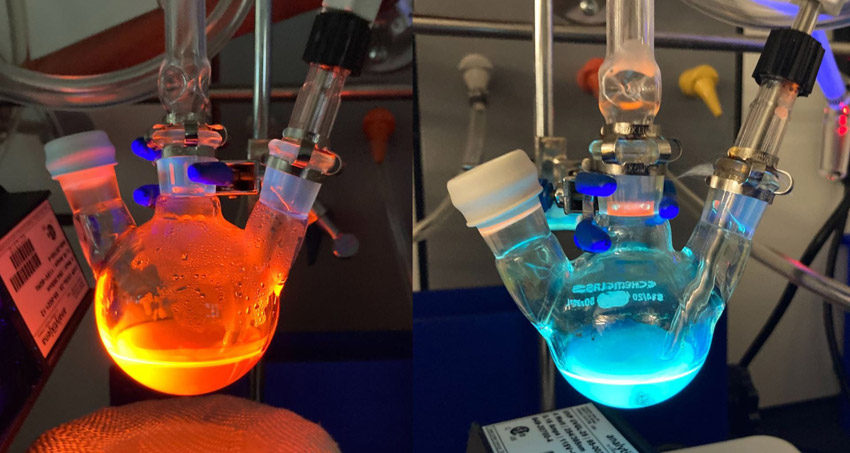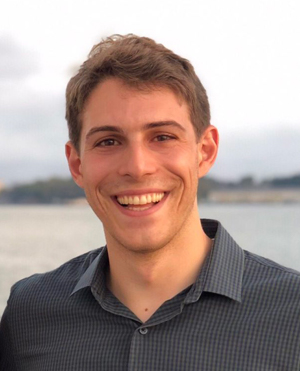
In the lab, orange quantum dots (QDs) turn blue when zinc is added. Photo: Jacob Olshansky
Assistant professor Jacob Olshansky has won a grant from the American Chemical Society’s Petroleum Research Fund for his research on “tunable quantum dots as sensitizers for photocatalytic CO2 reduction.” What are quantum dots, you may ask? Think exceptionally tiny particles that can be used to capture and transfer energy, using light. Olshansky’s lab is now exploring how quantum dots might convert the thing we have far too much of—carbon dioxide—into a carbon-neutral fuel.

Jacob Olshansky, Chemistry
What are the current uses of light energy?
When light is absorbed, that energy has to go somewhere. For example, plants’ photosynthesis is taking light energy and turning that into chemical energy, which gives plants the energy to grow. In technological applications, we try to extract that energy to do something useful. For example, solar cells take light energy and turn it into electricity.
What will your new grant make possible?
It gives me funding to put into practice a potential future alternative energy technology. The grant allows me to fund student researchers to engage in hands-on work with artificial photosynthesis—using light to convert carbon dioxide into a fuel. I've spent years doing research on very fundamental aspects of materials that could be used in alternative energy technologies, but now we're actually going to be able to test these materials and see how well they do.
How are quantum dots used today?
Quantum dots are in many displays including the red and green pixels of QLED TVs. They are technologically useful, because they grow in solution and can be “tuned” to emit light of any color. Their size dictates their color. They’re also robust. You can shine light on them all day and they’ll keep re-emitting that light without degrading.
Your lab is exploring multiple applications for quantum dots, but what is their function in this specific project?
I am looking for a way to use light-absorbing quantum dots and sunlight to create a carbon-neutral fuel. In other words, we’ll use the cheap energy from sunlight to convert the carbon that is already in the atmosphere into a fuel that you would burn again—something that you could actually use to run a car or a fuel cell. That type of technology is not widely available at the moment.
I use ‘we’ a lot when I talk about science, because science is so collaborative; I never do anything alone.”
Would this technology help slow down climate change?
It’s carbon-neutral, in that you take carbon dioxide, turn it into a fuel and then it burns and becomes carbon dioxide again. It’s not net-negative, but it’s a step in the right direction.
Have you always been interested in alternative energies?
Yes. In college, I was inspired by chemistry research that has an impact. I specifically wanted to do solar energy conversion, because [the sun] is this cheap energy source hitting the earth all the time. I thought, ‘Why can’t we take advantage of that?’ That was a huge motivation for me going to graduate school.
You were co-publishing scientific papers way back in 2011, when you were still an undergraduate. Has that shaped how you involve students in your lab here at Amherst?
For three summers, I did research in Professor Alex Norquist’s lab at Haverford College. That early experience convinced me how useful and important it is to get students involved in research as undergraduates. It motivated me through grad school and my postdoc to always mentor grad and undergraduate students, and then to come to an institution that prioritizes undergraduate education, especially via independent research. Having a handful of published projects on my CV as an undergraduate gave me a lot of confidence in pursuing a career in science and chemistry. I hope to provide the same for students who work with me, by involving them in cutting-edge research that relates to things that students may be very passionate about, like alternative energy.
Can you talk about the philosophies that guide the Olshansky lab?
I use “we” a lot when I talk about science, because science is so collaborative; I never do anything alone. My research group consists of myself and five students. And honestly, they’re doing all the actual lab work and data analysis at the moment. Another of the major tenets of my research group is that failure is OK. Especially in scientific research, an experiment will often fail or not produce the results that you expected. But those failures can be very interesting and can be turned into successes.